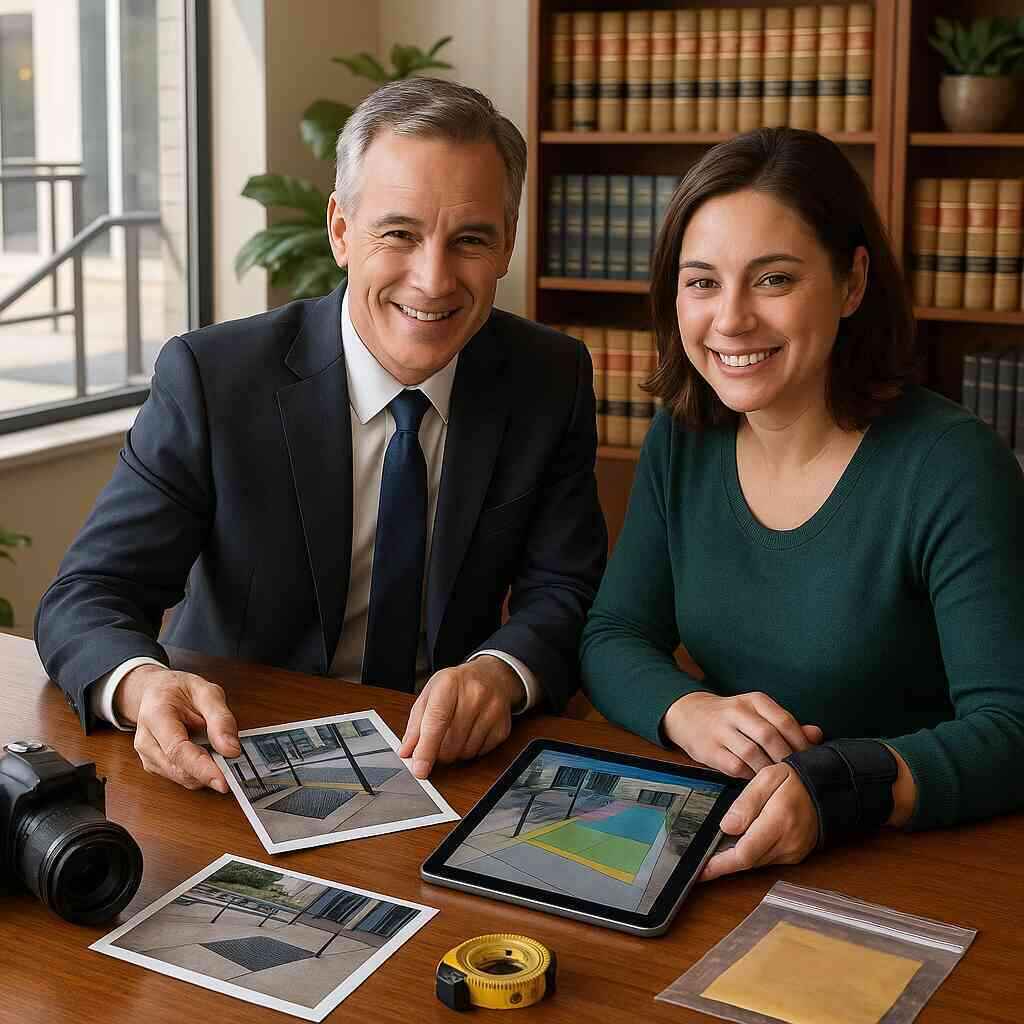 Posted On: 07/24/2025
Posted On: 07/24/2025Navigating the Legal Landscape
The Evolution of Personal Injury Law in 2025
In 2025, personal injury law has evolved significantly, driven by societal changes and technological advancements. As legal professionals continuously adapt to new standards, the impact on personal injury cases is considerable. With modern interpretations of liability and damages, the legal framework has become more nuanced, catering to the complexities of contemporary cases. For those involved in motor vehicle accidents or facing negligence in injury cases, these legal shifts can spell the difference between compensation and distress. Understanding how these changes affect personal injury law helps victims prepare better for their claims, ensuring they receive the appropriate redress.
Harnessing Modern Legal Strategies for Today’s Cases
With the rapid progression of technology, personal injury attorneys are redefining how they approach cases. Advanced legal strategies now include robust data analytics and comprehensive digital tools, enabling the precise reconstruction of events, particularly in complex scenarios like medical malpractice or wrongful death claims. Optimizing settlement outcomes relies not only on technical skills but also on strategic negotiation with insurance companies. This empowers law firms to maximize compensation for their clients while maintaining a focus on streamlined processes. For example, leveraging AI for legal research and case preparation streamlines the entire legal process, allowing for timely resolutions of even the most challenging personal injuries.
Connecting with Legal Professionals Using Technology
Technology bridges the gap between personal injury victims and legal professionals, ensuring swift and efficient communication. In 2025, finding a Personal Injury Lawyer in New York or any other state can be accomplished with a few clicks, thanks to platforms like Personal Injury Law Locator. This ease of access ensures that victims are quickly connected to the legal expertise they require. Moreover, virtual consultations and digital management tools offer victims the convenience of engaging with their legal team remotely, ensuring that geographical constraints do not hinder the pursuit of just compensation. These advancements make navigating the legal landscape more accessible, empowering victims with the resources they need to claim their rights effectively.
1 – Harnessing AI and Technology
Integrating Artificial Intelligence in Legal Research
In 2025, artificial intelligence (AI) has revolutionized the landscape of legal research for personal injury cases. AI-powered tools enable attorneys to swiftly and efficiently scour vast legal databases, thereby pinpointing pertinent precedents and statutes with incredible precision. These advanced systems also provide predictive analytics, forecasting potential case outcomes based on critical factors such as past judgments, jury tendencies, and settlement trends. Consequently, personal injury lawyers are better equipped to tailor their legal strategies to the nuances of each case. The use of AI streamlines the entire research process, significantly reducing preparation time and allowing legal teams to focus their efforts on client advocacy. This cutting-edge approach ensures that injured parties receive meticulously prepared legal representation, enhancing their chances for favorable resolutions.
Advancements in Case Management Software
The advent of sophisticated case management software has transformed the administration of personal injury lawsuits, enhancing efficiency and accuracy. In 2025, these digital platforms consolidate case files, medical records, and correspondences into a singular, accessible interface, greatly simplifying case oversight for legal professionals. Automation features help manage deadlines, track legal research progress, and prioritize tasks, ensuring that nothing falls through the cracks. This seamless integration of information allows attorneys to monitor and adjust their strategies dynamically, optimizing their approach to align with evolving case dynamics. Additionally, these platforms facilitate transparent communication between lawyers and clients, fostering trust and cooperation. For victims seeking legal recourse for personal injuries, such advanced software tools are indispensable in maintaining smooth and effective legal proceedings.
The Role of Virtual Reality in Accident Reconstruction
In the realm of accident reconstruction, virtual reality (VR) plays a groundbreaking role by providing immersive and realistic simulations of incidents. By reconstructing the events leading to a personal injury, VR enables legal professionals to analyze the intricacies of the scenario from multiple perspectives, thereby uncovering critical details pivotal to the case. For instance, in complex car accident claims where determining liability is challenging, VR technology offers unparalleled clarity. It allows juries and judges to virtually experience the accident, leading to a more informed and empathetic understanding of the plaintiff’s situation. As personal injury attorneys leverage VR in their evidentiary presentations, they are able to offer compelling visual narratives that can sway courtroom opinions. This technological advancement has become a cornerstone in advocating for justice and securing the compensation victims rightfully deserve. To see how these innovations integrate into personal injury cases, one can consult resources on Optimizing Settlement Outcomes: The Law Locator Approach.
2 – Strategic Settlement Tactics
Navigating Negotiations with Insurance Companies
In 2025, adeptly navigating negotiations with insurance companies has become crucial for personal injury claimants seeking justice. Insurance firms, armed with advanced algorithms, now predict settlement outcomes more accurately than ever. Therefore, injured parties must approach these negotiations with an arsenal of precise data and a robust strategy. Successful personal injury lawyers are using detailed documentation of accidents and injuries alongside persuasive communication techniques. It is imperative for victims to work with a Personal Injury Lawyer in Pennsylvania who can effectively advocate on their behalf. Expert negotiation often demands a strategic presentation of facts and evidence tailored to the insurer’s expectations, ensuring victims attain fair compensation for their losses and suffering.
Leveraging Data Analytics for Maximum Compensation
The power of data analytics in 2025 lies in its ability to pinpoint the optimal compensation for personal injury claims. Attorneys now employ sophisticated analytical tools to dissect injury-related data, such as historical claim outcomes, regional compensation standards, and precedents set by courts. This level of detail helps in predicting settlement ranges and crafting compelling arguments that highlight the full impact of injuries, including medical expenses and property damage. In an environment where efficiency and accuracy are paramount, legal teams achieve maximum compensation by utilizing insights drawn from this data. For instance, consulting resources like Advanced Insights for Winning Settlement Tactics 2025 can yield strategies that align with contemporary litigation trends, helping injured parties secure their rightful compensation.
Adopting Modern Mediation Techniques
As the legal field embraces innovation, modern mediation techniques have surfaced as pivotal tools for resolving personal injury disputes. Mediation, historically guided by a mediator’s discretion, now benefits from digital platforms allowing for structured and efficient dialogue between opposed parties. In today’s landscape, victims and insurers engage in virtual mediation sessions, which streamline the resolution process and reduce prolonged courtroom battles. This evolution in mediation offers a more adaptable and cost-effective approach, expediting settlements while fostering satisfaction among all parties involved. By embracing these techniques, legal practitioners enhance their ability to resolve civil cases amicably. Tapping into resources such as Exploring Innovative Law Locator Strategies for 2025 equips attorneys with cutting-edge methods that ensure fairness and expediency in reaching a mutually agreeable resolution for personal injuries.

3 – Evolving Legal Representation Models
Rise of Online Legal Consultations
In 2025, the emergence of online legal consultations has transformed how personal injury victims access legal services. With the convenience of digital platforms, injured parties can connect with a Personal Injury Lawyer in Florida or elsewhere without stepping outside their home. These virtual consultations eliminate geographical barriers, broadening access to personal injury attorneys across the United States. Clients benefit from immediate guidance during critical post-injury phases, enhancing their ability to initiate legal claims promptly. The shift to online consultations fosters inclusivity and empowers victims with immediate access to legal expertise tailored to their specific needs.
Online consultations provide significant advantages in terms of time and cost efficiency. Personal injury victims can discuss their cases in real time, receiving strategic legal insights that might traditionally require multiple in-person visits. Legal professionals leverage technology to offer preliminary case analyses and assessments, expediting the decision-making process. Additionally, these virtual engagements allow for flexible scheduling, accommodating clients’ needs and ensuring that legal services are accessible when they need it most. This modern approach positions personal injury law within the broader technologically driven landscape, paving the way for more adaptive and responsive legal practices.
Comparing In-Person vs. Virtual Legal Representation
As the legal industry evolves, comparing in-person to virtual representation yields critical insights into which model best serves personal injury victims. In-person legal representation offers tangible benefits such as face-to-face interaction, which can enhance communication and the attorney-client relationship. For victims of serious car accidents or medical malpractice, discussing complex legal issues in a physical setting may provide clarity and assurance. However, virtual legal representation presents compelling benefits, including wider access to specialized attorneys and increased flexibility in attending consultations.
Virtual representation caters to the modern client’s needs, accommodating those who may have mobility challenges or reside in remote areas. It is especially beneficial for individuals who need to connect with a specialized Personal Injury Lawyer in California, ensuring that geographic limitations do not hinder access to top-notch legal expertise. Moreover, advancements in secure digital communications have mitigated concerns regarding confidentiality, making online platforms a viable and safe alternative. Ultimately, the choice between in-person and virtual representation depends on individual preferences and specific case requirements. Victims should evaluate their priorities and circumstances to determine which framework aligns best with their pursuit of justice and compensation.
Emerging Billing Structures for Legal Services
In the landscape of 2025, evolving billing structures for legal services offer personal injury victims transparency and flexibility. Traditional hourly billing models are giving way to more client-centric approaches, such as contingency fees, where attorneys receive payment only if the client secures a settlement. This model aligns the financial interests of both parties, encouraging legal practitioners to pursue maximum compensation. Increasingly, firms are adopting hybrid billing models that combine hourly fees and success-based elements, providing a balanced framework that caters to diverse client needs.
The rise of transparent billing structures enhances trust between clients and their legal representatives. Personal injury law firms are leveraging technology to present clear, itemized billing statements, ensuring clients comprehend their legal expenses. This modern approach emphasizes fairness and accountability, making legal services more accessible to everyone. As clients seek legal counsel for various matters, such as workplace injuries or Damages in personal injury, understanding the nuances of billing practices becomes essential for informed decision-making. Ultimately, the evolution of billing structures reflects the legal sector’s commitment to delivering quality services while adapting to contemporary economic realities.
4 – Innovative Claim Processes
Streamlining the Filing Process with Digital Tools
The advent of digital tools in 2025 has dramatically streamlined the filing process for personal injury claims. Personal injury lawyers now utilize online platforms to submit paperwork, reducing the time traditionally spent on manual filing. This shift is driven by user-friendly interfaces that allow injured parties to track their claims in real-time, ensuring transparency throughout the process. For those engaging with a Personal Injury Lawyer in Texas, these tools facilitate immediate communication and submission of documents, expediting the legal journey. Notably, these digital solutions minimize human error, ensuring that all claim details are precise and comprehensive, thus enhancing the odds of securing a favorable outcome for the claimants.
Modern filing solutions also incorporate automated reminders and alerts that notify attorneys and clients of upcoming deadlines. This feature prevents claims from being jeopardized by missed deadlines, supporting a smoother litigation process. Additionally, integration with other legal software allows for seamless data sharing with insurance companies and opposing legal teams, making negotiation more efficient. The rise of these digital tools exemplifies how embracing technology not only streamlines operations but also empowers injured parties by simplifying the complexities traditionally associated with filing injury claims.
Understanding New Trends in Claim Documentation
In 2025, new trends in claim documentation are changing how personal injury lawyers compile and present evidence. With the progress in technology, digital documentation has become more sophisticated, incorporating elements such as high-resolution images, detailed video footage, and comprehensive digital medical records. Law firms are increasingly leveraging cloud-based storage solutions, ensuring secure and organized access to all pertinent files. This shift enables lawyers to provide more robust evidence, which is crucial for personal injury claims.
Moreover, injured individuals can now use mobile applications to document their injuries and recovery progress in real-time. These apps allow for the quick capture of photos and notes, attaching timestamps and geolocation data to bolster the authenticity and strength of the evidence. Such meticulous record-keeping is invaluable when constructing a case, as it paints a clear picture of the medical bills, property damage, and emotional distress experienced by the injured party. For legal experts interested in understanding more about these trends, consulting resources like Advanced Strategies for Excelling in Complex Injury Cases can provide deeper insights into how these modern practices enhance legal outcomes.
Exploring Alternative Dispute Resolution Methods
Alternative dispute resolution (ADR) methods in personal injury law are gaining traction as effective solutions for resolving claims outside of court. In 2025, mediation and arbitration have become preferred avenues, driven by their cost-effectiveness and speed compared to conventional litigation. This trend is particularly beneficial for personal injury claims, such as motor vehicle or medical malpractice cases, where early settlements can prevent drawn-out court battles.
Law firms are now embracing ADR platforms that facilitate virtual mediation sessions, allowing involved parties to negotiate settlements in a structured digital environment. This reduces the emotional and financial burdens often associated with court proceedings. By bypassing traditional courtroom disputes, ADR methods provide an arena for parties to reach mutually agreeable resolutions through collaboration and compromise. As an evolving trend, personal injury victims are encouraged to explore ADR channels, supported by a robust legal team. For those intrigued by contemporary legal strategies, reviewing Unveiling the Future of Personal Injury Practices in 2025 offers a comprehensive view of how these methods are shaping the future of injury claims.
5 – Adapting to 2025 Litigation Trends
Shifts in Jury Perceptions and Outcomes
As the landscape of personal injury law evolves, notable shifts in jury perceptions and outcomes have emerged in 2025. Jurors are now better informed, often relying on digital platforms and advanced data during trials. This access to information has heightened their expectations of evidence clarity and impact. Personal injury lawyers must adapt by presenting compelling narratives and leveraging technological tools, such as virtual reality, to sway jury opinions. The use of AI-driven analytics to predict jury decisions adds another layer of complexity, prompting attorneys to adopt refined strategies. Such insights are crucial for personal injury victims to anticipate how their case may unfold in court, ultimately influencing their approach to litigation.
A significant trend is the jury’s increasing sensitivity to issues related to emotional distress and psychological harm. As understanding of mental health has grown, jurors are more receptive to claims emphasizing these aspects. Attorneys representing injured parties should prepare comprehensive presentations, highlighting emotional and psychological impacts alongside physical injuries. This focus on holistic recovery can resonate more deeply with modern juries, potentially leading to more favorable outcomes for personal injury claims.
Preparing for Changes in Courtroom Procedures
Courtroom procedures in 2025 reflect groundbreaking advancements in technology and legal frameworks. Digital evidence submission is now the norm, streamlining processes and enhancing transparency. Legal teams are advised to become proficient in managing digital exhibits, ensuring the seamless integration of electronic evidence during trials. The sophistication of courtroom technology demands that personal injury lawyers stay ahead, incorporating virtual presentations and digital demonstrations into their strategies.
The rise of remote court appearances is another significant procedural shift. Remote hearings via secure digital platforms offer flexibility and can expedite proceedings, making the legal process less burdensome for personal injury victims. Lawyers and clients must adapt to these virtual environments and hone their communication skills for digital interactions. This shift encourages a more agile approach to legal representation, fostering responsiveness and adaptability in personal injury cases.
Impact of New Legislation on Personal Injury Cases
Legislation continues to shape the trajectory of personal injury law, with new laws and regulations emerging in response to societal and technological changes. In 2025, legislators will focus on addressing nuances in insurance and liability, impacting personal injury litigation. For instance, changes in motor vehicle accident laws prioritize safety technology and influence claim evaluations. Staying abreast of these legislative developments is crucial for victims seeking to maximize their compensation.
Law firms leverage advanced analytical tools to assess the implications of new laws on ongoing and future cases. By understanding legislative trends, personal injury attorneys can provide strategic guidance, ensuring compliance and optimizing claim potential. Resources like Find Personal Injury Lawyers can connect injured parties to skilled legal professionals well-versed in these dynamic legal environments. This proactive approach enables individuals to navigate the evolving legal framework confidently, securing just resolutions for their personal injury claims.

Anticipating Future Challenges
Preparing for Unforeseen Legal Obstacles
As we move through 2025, personal injury law continues to navigate an ever-shifting landscape marked by complex legal challenges. Injury victims face new hurdles that require astute preparation and strategic foresight from legal professionals. Understanding potential obstacles is critical for personal injury lawyers aiming to preempt challenges before they arise. The legal community anticipates evolving regulations affecting liability and compensation, necessitating proactive measures to shield clients from adverse legal impacts. Preparing for such obstacles ensures that victims of personal injuries maintain their rights and secure just settlements.
In this unpredictable legal environment, personal injury attorneys need to develop innovative approaches that adapt swiftly to new challenges. Utilizing advanced technology like AI-driven scenario simulations empowers legal teams to anticipate possible hurdles and develop preemptive strategies. These simulations provide robust insights into emerging issues, allowing lawyers to modify protocols effectively. By doing so, injured parties benefit from a legal strategy tailored to withstand unforeseen complications, thereby maximizing their potential for favorable outcomes. Engaging with a seasoned Personal Injury Lawyer in Georgia can be instrumental in navigating such complex legal terrains.
Contingency Planning in a Changing Legal Environment
In 2025, the importance of contingency planning has gained prominence in personal injury litigation due to the ever-evolving legal environment. This approach ensures legal teams are prepared for unexpected developments, such as shifts in jury dynamics or sudden legislative amendments. Law firms representing injured parties are now incorporating contingency protocols into their practice to mitigate risks and safeguard clients’ interests effectively. This proactive planning involves flexible case strategies adaptable to varying court conditions, enabling attorneys to maintain the upper hand.
Contingency planning empowers personal injury lawyers to deliver consistent outcomes by preemptively analyzing potential scenarios and preparing adaptive responses. Firms utilize comprehensive data analytics and predictive tools to foresee possible changes and align strategies with current legal and societal trends. In this dynamic environment, collaboration among team members remains essential. Maintaining an agile legal team ensures that contingency measures are seamlessly executed, providing stability and reassurance for clients navigating the complexities of personal injury claims.
Staying Informed: Continuous Legal Education
In the fast-paced world of personal injury law, continuous legal education is vital for practitioners committed to staying ahead. Legal professionals must constantly update their knowledge to remain informed of new legal precedents, technological advancements, and evolving best practices. These educational initiatives play a crucial role in equipping attorneys with the skills needed to tackle the challenges of modern personal injury cases. By engaging in ongoing learning, lawyers ensure they are prepared to offer premium legal services to clients.
Opportunities for legal education are abundant and diverse, ranging from accredited courses to legal seminars and industry conferences. By actively participating, personal injury attorneys gain insights into cutting-edge technologies, such as AI-driven legal research and virtual reality modeling, which are redefining case preparation and presentation. Additionally, fostering a culture of continuous learning within law firms promotes innovation and adaptability. Staying ahead in personal injury legal claims not only benefits victims seeking justice but also strengthens the overall efficacy and credibility of personal injury law practices.
By understanding the necessity of future-readiness, attorneys can better serve their clients, ensuring they meet the evolving challenges presented by the dynamic legal landscape in personal injury law.
Conclusion: The Road Ahead in Personal Injury Law
Summarizing Key Legal Insights for 2025
As 2025 unfolds, personal injury victims are witnessing a transformative era in legal practices. Staying informed of these key insights is crucial for navigating this complex landscape effectively. The integration of advanced technologies such as AI, VR, and data analytics empowers both victims and legal professionals in optimizing outcomes. Furthermore, evolving strategies in settlement negotiations and legal representation models are providing unprecedented opportunities for securing rightful compensation. Understanding these dynamic shifts is essential for maximizing personal injury claims and achieving justice.
Embracing Change and Innovation in Legal Practices
In an industry characterized by rapid advancements, embracing change is not merely an option but a necessity for thriving. Personal injury law is undergoing a significant metamorphosis, driven by innovative approaches and forward-thinking strategies. Lawyers and clients alike must adapt to digital transformations in claim processes and courtroom procedures, ensuring they remain at the forefront of effective legal advocacy. Additionally, the adoption of modern settlement procedures in litigation is shaping litigation practices, offering a streamlined path to resolution. By continuously evolving, the legal community is poised to meet future challenges head-on, delivering enhanced services to those who need them most.
Empowering Victims with Knowledge for Future Cases
Knowledge is a vital tool for empowerment, especially for victims pursuing personal injury claims. As the landscape becomes more intricate, remaining informed about legal trends and developments is imperative. Resources such as personal injury guidelines and access to esteemed Personal Injury Lawyers in legal representation can provide invaluable support. By leveraging these assets, injured individuals can navigate their legal journeys with confidence and clarity. The future of personal injury law promises continued innovation, and by arming themselves with knowledge, victims can ensure their rights are upheld and their recoveries are justly pursued.
Frequently Asked Questions
Question: What advanced technologies are Personal Injury Law Locator professionals employing to enhance personal injury claims in 2025?
Answer: At Personal Injury Law Locator, our professionals employ cutting-edge technologies such as artificial intelligence and virtual reality to optimize personal injury claims in 2025. AI assists in swiftly analyzing vast legal databases to identify pertinent precedents, enhancing our strategic approach and ensuring our clients receive precise and efficient legal advocacy. Meanwhile, virtual reality plays a crucial role in accident reconstruction, allowing for immersive simulations that bring clarity and a deeper understanding to complex scenarios, such as car accident claims. By integrating these technologies into our case strategy, we maximize compensation for injured parties, safeguarding their rights while ensuring justice is appropriately served.
Question: How does Personal Injury Law Locator ensure victims are quickly connected to legal professionals across the United States?
Answer: Personal Injury Law Locator excels in connecting victims with personal injury lawyers across all 50 states with remarkable speed and efficiency. Utilizing our comprehensive online platform, injured individuals can locate top-tier personal injury lawyers near them with just a few clicks. This ease of accessibility ensures that victims receive immediate support and expert guidance from dedicated personal injury attorneys who understand the nuances of state-specific laws. Whether it’s a motor vehicle accident, workplace injury, or nursing home abuse case, our cross-national service ensures you have the optimal legal support to pursue your claim effectively.
Question: What makes Personal Injury Law Locator the right choice for navigating the complex legal landscape of personal injury law in 2025?
Answer: Navigating the personal injury law landscape in 2025 requires both innovation and expertise, which Personal Injury Law Locator is well-positioned to offer. We harness advanced legal strategies, combining data analytics, AI tools, and strategic negotiation tactics, to ensure you secure the rightful compensation for your injury claims. Our dedicated personal injury attorneys are well-versed in contemporary legal tactics and focused on providing customized service tailored to the unique circumstances of each case. By choosing Personal Injury Law Locator, you align with a leading authority in personal injury law with a proven track record of securing optimal settlements and verdicts for clients across the US.
Question: In the blog Top 5 Legal Insights for Personal Injury Victims in 2025, how does Personal Injury Law Locator assist clients in achieving maximum compensation through strategic settlement negotiations?
Answer: As highlighted in our blog Top 5 Legal Insights for Personal Injury Victims in 2025, Personal Injury Law Locator empowers clients by employing strategic settlement negotiation tactics to maximize compensation. Our approach utilizes sophisticated data analytics to dissect and present compelling injury-related data, ensuring that all aspects of a claim are meticulously detailed. We work in tandem with expert personal injury attorneys who specialize in crafting persuasive communication strategies, ensuring that insurers recognize the full impact of injuries, from medical bills to emotional distress. By focusing our negotiation efforts on factual accuracy and strategic presentation, we optimize outcomes and uphold your rights to fair compensation.
Question: How does Personal Injury Law Locator utilize alternative dispute resolution methods for efficient personal injury case resolutions?
Answer: Personal Injury Law Locator leverages alternative dispute resolution methods, such as mediation and arbitration, to provide cost-effective and expedited personal injury case resolutions. By facilitating virtual mediation sessions through advanced digital platforms, we streamline negotiations, allowing for structured dialogue that often leads to mutually beneficial settlements. These methods reduce the need for prolonged court battles, offering quicker resolutions and enhanced satisfaction for all parties involved. We collaborate with leading personal injury attorneys skilled in ADR techniques to ensure that every case is handled with precision and efficiency, aligning with our commitment to securing justice and compensation for injured individuals.


